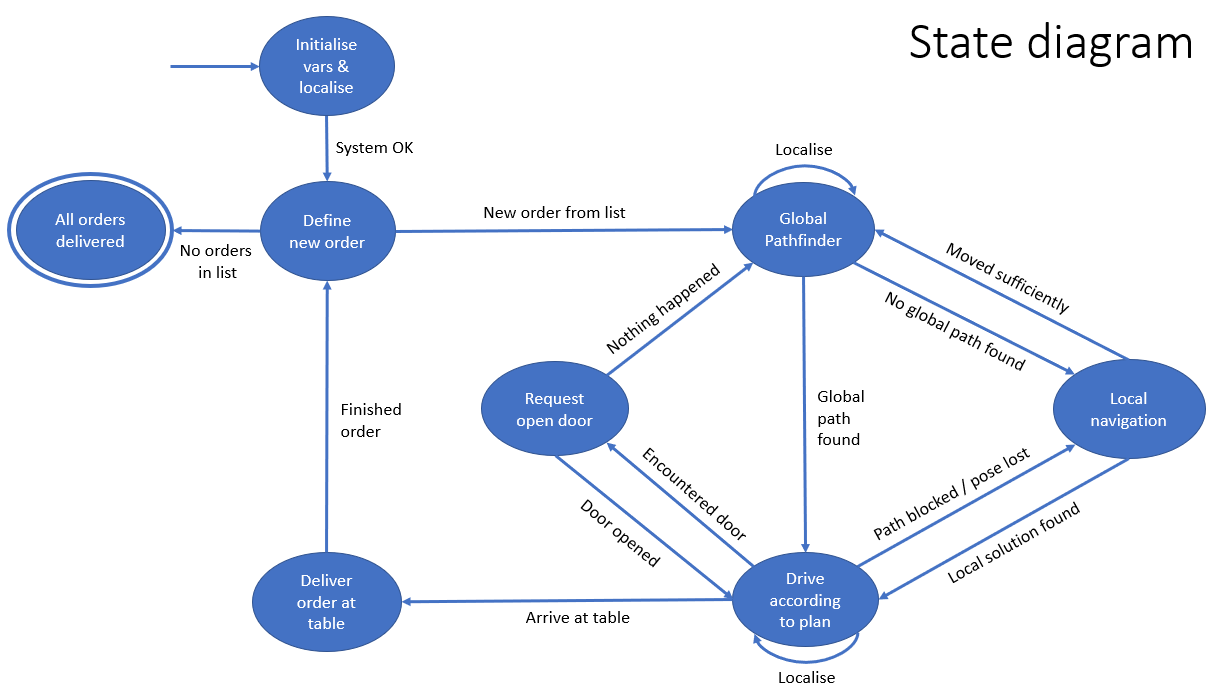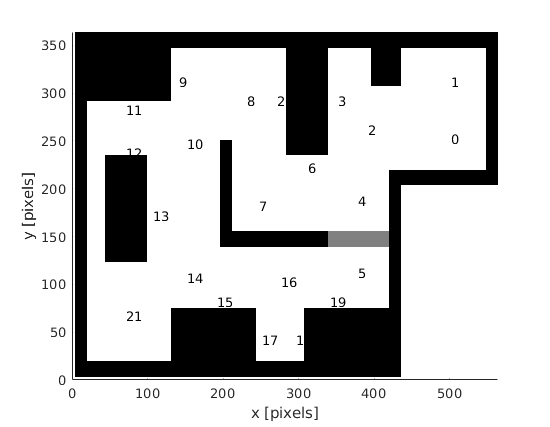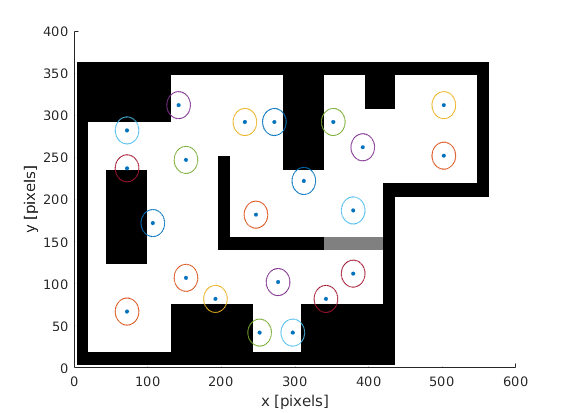Mobile Robot Control 2023 Rosey
Welcome to the group page of team Rosey! This page is currently under construction.
Project organisation
| Name | Student ID |
|---|---|
| Eline Wisse | 1335162 |
| Lotte Rassaerts | 1330004 |
| Marijn Minkenberg | 1357751 |
| Rainier Heijne | 1227575 |
| Tom Minten | 1372300 |
| Lowe Blom | 1266020 |
Midterm presentation
During the midterm presentation, team Rosey presented their plan of action to make the robot deliver orders in a restaurant. The slides are available below for comparison to the final product.File:Midterm presentation Rosey.pdf
Work division
The group identified three 'major parts' of the assignment. These are the localisation, the global and local navigation of the robot. The group additionally saw use for an overseeing role, which should ensure that the interfaces between the functions are clear. The work is divided as follows:
- Marijn : System architecture and overview
- Tom : Global navigation
- Eline & Rainier : Local navigation
- Lowe & Lotte : Localisation
System architecture and overview
...
Current state diagram

The global navigation uses the A* algorithm to find the shortest path to from a starting node to a goal node. The A* algorithm uses a predefined grid of nodes. This grid is applied by a JSON file, generated with Matlab. With Matlab, the grid nodes with their connections are manually chooses in the known map. On top of that, we were inspired by the lecture about Safe navigation in a hospital environment to introduce some context-aware navigation into our model, by means of semantics. Each node contains some semantic information about its environment, described by a integer. The following semantic integers are included: 0 = table 0, 1= table 1, ..., 49 = table 49, 50 = door, 99 = empty (meaning no semantic information present). This information is also included in the JSON file. The global path finder can find a table by looking for the node with the corect semantic integer.
Preparation phase
Create a JSON containing the grid information with the Matlab script below. The script has a visualization tool for plotting the position of all nodes. In the next graphs, the locations of the grid points in the final challenge are visualised. The circle has a radius of 20 centimeters. The local navigation assumed that the robot has reached the node when it is 20 centimeters from the node.
The corresponding Matlab script to generate the graphs and the JSON grid file: (click 'Expand'):
%% Data
clear all;
% Points in pixels, personally used pinta for that
x = [500,500,390,350,377,377,310,245,230,140,150,70,70,105,150,190,275,250,295,340,270,70];
y = [110,50,100,70,175,250,140,180,70,50,115,80,125,190,255,280,260,320,320,280,70,295];
% move zero point for matching worldmodel
x = x+2;
y = (y*-1+362);
% scale to meter
res= 1/80; % 80 pixels per meter
x_m = x*res;
y_m = y*res;
%% semantics
% add semantics to certain nodes
% 0: table 0, 1: table 1, ... 49: table 49, 50: door, 99: empty
% also add coordinates of the semantic objects when necessary
sem(1:length(x)) = 99; % fill array with 99 (empties)
semx(1:length(x)) = 0; % fill array with 99 (empties)
semy(1:length(x)) = 0; % fill array with 99 (empties)
sem(10) = 0;
semx(10) = 0.9375;
semy(10) = 4.0625;
sem(12) = 0;
semx(12) = 0.9375;
semy(12) = 4.0625;
sem(4) = 1;
semx(4) = 3.8750;
semy(4) = 3.7500;
sem(7) = 1;
semx(7) = 3.8750;
semy(7) = 3.7500;
sem(21) = 1;
semx(21) = 3.8750;
semy(21) = 3.7500;
sem(13) = 2;
semx(13) = 0.8750;
semy(13) = 2.2500;
sem(14) = 2;
semx(14) = 0.8750;
semy(14) = 2.2500;
sem(16) = 3;
semx(16) = 2.3750;
semy(16) = 0.5625;
sem(18) = 3;
semx(18) = 2.3750;
semy(18) = 0.5625;
sem(20) = 4;
semx(20) = 4.6250;
semy(20) = 0.5625;
sem(19) = 4;
semx(19) = 4.6250;
semy(19) = 0.5625;
doorNodes = [5,6] % door nodes
for i =1:length(doorNodes)
sem(doorNodes(i)) = 50;
end
%% connections
% define connections for each node, using input mode of matlab
conn_challenge_restaurant = zeros(length(x),10);
for i = 1:length(x)
i
prompt="type Connections, in form [a,b] when more connections exists: "
output = input(prompt)
for j = 1:length(output)
conn_challenge_restaurant(i,j) = output(j)
end
end
%% Plot
close all;
figure()
text(x, y, string((1:numel(x))-1)); % python numbering (index 0:..)
%text(x, y, string((1:numel(x))-0)); % matlab numbering (index 1:...)
axis([0, 564, 0, 364])
hold on
% visualise bitmap with points
I = imread('RestaurantChallengeMapRotatedFlipH.png');
h = image(2,2,I);
uistack(h,'bottom')
% size of points, which forms the circle around node
sm = 10;
% radius of circle about node
R = 16; % 0.2*80, 20 centimeter radius
th = linspace(0,2*pi) ;
figure()
scatter(x,y,sm,"filled")
hold on
for i = 1:length(x)
x_c = R*cos(th)+x(i) ;
y_c = R*sin(th)+y(i) ;
scatter(x_c,y_c,1,"filled")
end
I = imread('RestaurantChallengeMapRotatedFlipH.png');
h = image(2,2,I);
uistack(h,'bottom')
%% generate JSON
S.nodes = struct("x", num2cell(x_m), "y", num2cell(y_m), "semantic",num2cell(sem),"semanticX",num2cell(semx),"semanticY",num2cell(semy))
S.connections = conn_challenge_restaurant
s = jsonencode(S,PrettyPrint=true)
if exist('grid.json', 'file')==2
prompt="do you want to remove old grid.json file? (y=1/n=0) "
output = input(prompt);
if output == 1
delete('grid.json');
disp("Caution, old grid.json file is deleted...")
end
end
fid=fopen('grid.json','w');
fprintf(fid, s);
disp("new grid.json is succesfully saved")
Initiation phase (run once)
The json file is imported with the loadConfigFile()and the grid is constructed withconstructGrid(). The grid information is placed in the global variable *grid.
Global path finder phase
In globalNavigation(), there are a few steps which has to be taken for determining the best path as node sequence.
- First, the robot determines its own position in its map and the closest node is found. One assumed that there is no complete blocking object as a wall in between the robot and the closest node, i.e. sufficient nodes has to be properly placed.
- The goal node is found by finding the corresponding semantic number of the destination table
- The
aStar()is executed to find the best path - In case the output is [-1], there is no path available with the provided information. Possibly causes: connections are not correctly defined or essential connections are removed. On the end, the output with the sequence of nodes to (and including) the goal node is written to the global*pathNodeIDsvariable. - The main function returns whether a path is found.
Cutting connections in case of blocking objects or close doors (updating the grid)
Note that the code for updating the grid is present, but not implemented in local navigation due to time constraints. So, it is not used. However, the plan for updating the grid will be explained below:
In case a node cannot be reached according to a certain trajectory, the grid information has to be revised by removing the connection between the last node and the not reachable node. Then, a new trajectory has to be determined while taking into account the removed connection. This should result in another trajectory to the goal, providing that the removed connection is not crucial. When defining the grid, one should take into account that a connection can be removed and that another trajectory still has to be possible. To remove a connection, the function cutConnections() can be used.
Note that a connection can be unavailable for a limited time. To handle that, the connections list has to be reset when a goal (e.g. table) is reached or when there are no other trajectories possible, due to all removed connections. In the grid, there are two connections list: one will be updated, while the other saves the initial connections list. To reset the connections list, the updated list is overwritten with the initial connections list. This can be done by using the resetConnections() function.
Known bug while selecting the table node
On the day before the demo day, we found out that the goal node selection is not perfect. Now, the node list is looped to find a node with the corresponding semantic integer for a certain table. So, the first node with this semantic integer is chosen directly. There are multiple nodes around the table which has the semantic integer for the specific table, but the lowest node number is always taken. Then, this node is used as finish node for the A* algorithm. For the demo, it was decided to only assign one node to each table. However during the demo, the specific node for the first table was giving problems. In case the selection of the goal node is able to take the closest table node, this issue was avoided by going to the closest table node on the side of the table.
The way to solve this bug is to generate different paths to all table nodes, check the cost to come for all available table nodes, and select the path with the lowest cost to come. Due to lack of time, this bug fix could not be implemented. In addition, when the cutConnections()is used, the robot can cut the connection when the table node is not reachable, which was the case during the demo. Then, another table node can be used to reach the table.
...
Localisation
...
Testing the software
Practical sessions
...
Final challenge day
...

